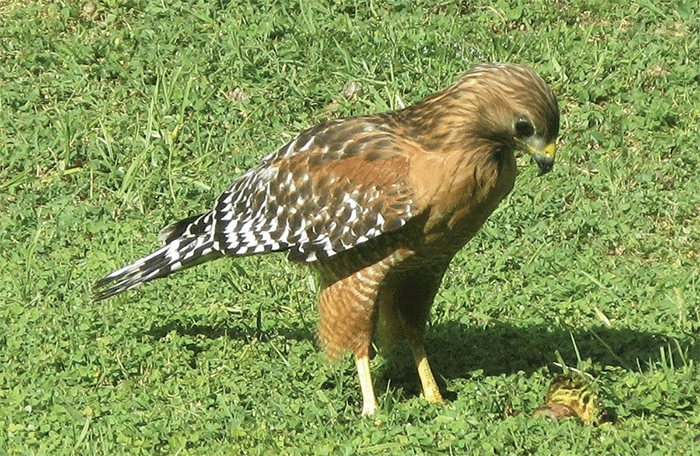Raptors and Ripe Fruit: A New Behaviour Emerges
Unexpected observations in suburban California show a bird of prey breaking dietary norms by feeding on fallen fruit

A surprising taste for avocado
Red-shouldered Hawks are known as adaptable forest hunters across North America, preying primarily on mammals, reptiles and amphibians. But new research from Santa Barbara, California, has revealed a strikingly different side to this bird of prey: a taste for ripe avocado fruit. Observations conducted between 2020 and 2024 have captured multiple instances of the Red-shouldered Hawk consuming avocado flesh from fallen fruit on suburban lawns, marking the first confirmed case of frugivory for this species.
These findings add the Red-shouldered Hawk to a growing but still limited list of raptor species known to consume fruit, bringing the total to 33 globally. They also challenge long-held assumptions about the strictly carnivorous habits of most raptors and prompt a reconsideration of how flexible these birds may be in adapting to human-altered landscapes and novel food sources.
Video evidence of deliberate feeding
The paper, authored by James A. Fitzsimons and colleagues, includes video and photographic documentation of multiple foraging events by hawks interacting with avocado fruits in a Santa Barbara garden. In one 8-minute video, a hawk was recorded performing at least 121 foraging manoeuvres—extracting flesh with its beak, repositioning the fruit with its feet, and even tolerating harassment by American Crows in order to keep feeding.
In several cases, the hawks were seen holding the fruit alternately with each foot, removing the skin with their beak and pecking repeatedly at the flesh. There was no evidence that the birds consumed either the pit or skin. The feeding was carried out on the ground, with hawks remaining vigilant—scanning the surroundings between bites as if watching for threats.
How unusual is fruit-eating in raptors?
While frugivory is rare among raptors, it is not entirely unheard of. Other species documented eating fruit include the Palm-nut Vulture, African Harrier-Hawk, and Black Kite. A handful of vultures and kites have also been observed consuming avocado flesh, but typically in regions where the fruit is abundant or where carrion is scarce. The Red-shouldered Hawk now joins that list, with a documented preference for the soft, high-fat flesh of ripe avocados.
Interestingly, the hawks in this study consumed avocados despite no apparent food shortage. The authors note that the lipid-rich composition of avocado flesh could make it an attractive supplementary food item, especially in winter or in urban settings where other prey may be less accessible or harder to catch.
Adaptability and urban foraging
The Red-shouldered Hawk has already been recognised as a successful urban adapter, known to inhabit riparian woodlands and suburban areas across the western and southeastern United States. This case of fruit consumption adds a new dimension to its ecological flexibility. It also reinforces previous findings that pellet analysis may underestimate certain dietary components—particularly soft or easily digested items such as fruit—which are unlikely to leave detectable traces.
Whether frugivory is widespread among Red-shouldered Hawks remains uncertain. The study could not confirm whether the same individual was responsible for all observations across five years, though some plumage differences suggest multiple birds may have been involved. Regardless, the repeat behaviour implies more than a one-off event, and perhaps a local tradition in this small urban population.
Implications for future research
This study contributes to a growing interest in non-traditional food habits among birds of prey. It follows recent documentation of Eastern Screech Owls consuming acorns and vultures selecting lipid-rich fruits even when carrion is available. The authors suggest that further field studies and urban foraging surveys are needed to understand the prevalence and ecological relevance of fruit consumption by raptors, particularly in light of changing climates and increasingly human-dominated habitats.
More broadly, the findings suggest that dietary flexibility may be more common among raptors than previously recognised, and that urban environments—rich in anthropogenic food resources—may encourage such novel behaviours.
20 May 2025
Share this story







